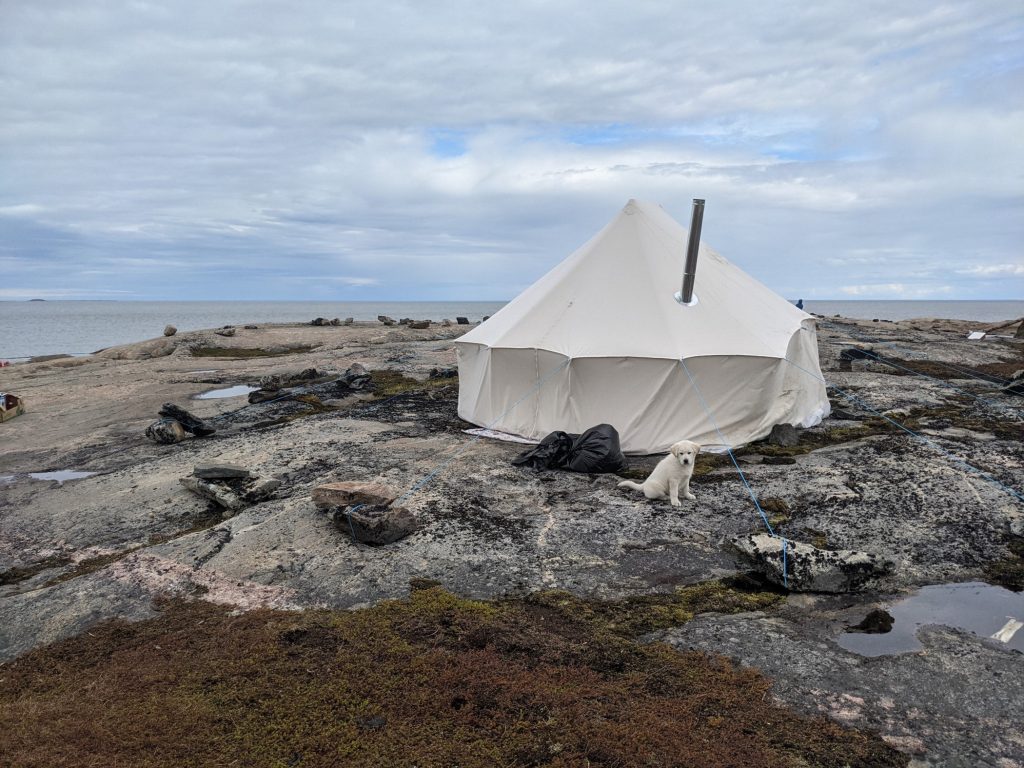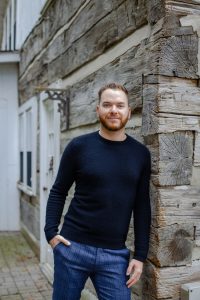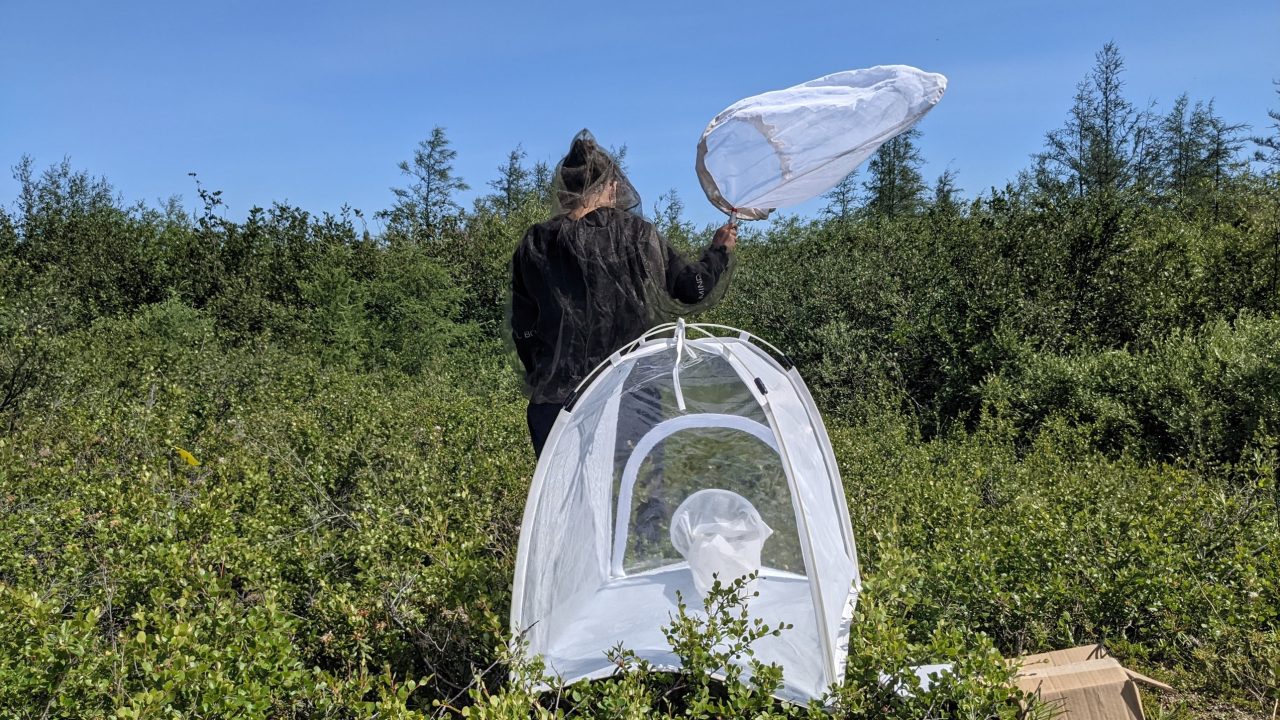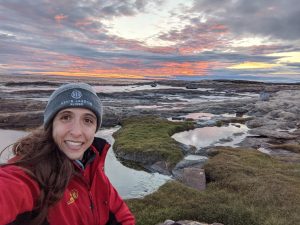Nunamit Takunnatut: Eyes on Wildlife – Community-based, Inuit health, wildlife health
Project overview
Sustainable and innovative community-based wildlife health monitoring in Nunavik
Durabilité et innovation par la surveillance communautaire de la santé de la faune au Nunavik
Nutaannguqtaqtut hanatuyullu nunallaarni-aulapkaiyut anngutighanik aanniaqtailiniqmut munaqtiuyut Nunavik-mi
ᐊᐅᓚᑦᑎᓂᕐᒧᑦ ᐊᔾᔨᐅᖏᑦᑐᓂᓪᓗ ᓄᓇᓕᓐᓂ ᐃᓅᓇᓱᐊᑦᑎᐊᕐᓂᖏᑦ ᐅᔾᔨᖅᓱᖅᑕᐅᓗᑎᒃ ᓄᓇᕕᒻᒥ
Global and environmental shifts (climate change, ecotourism, population growth, animal migration, pollution…) are driving changes in the presence and abundance of animal species and their pathogens which is impacting Inuit health and well-being. The goal of the Uumajutsianniartiit project is to develop resources to enhance Nunavimmiut observation, detection, and monitoring of changes in wildlife and their environment. This project is divided into three smaller projects. First, we want to understand community priorities in order to provide resources to develop culturally responsive monitoring system that integrates Inuit knowledge. Second, we want to develop an innovative way to detect wildlife changes in the environment using water from lakes and rivers. Lastly, knowledge exchange and capacity building between researchers and Nunavimmiut around wildlife health is key to this project. We wish to enhance skills in animal sample collection and testing, provide summer internships to Inuit students to experience lab work and have access to national conferences and traditional activities
Project location
This work will be undertaken in all 14 Nunavik communities with laboratory work and capacity building concentrated at the Nunavik Research Centre in Kuujjuaq.
Project images

Summary
Climate change is bringing new wildlife pathogens to the Arctic that can detrimentally impact Inuit health and wellbeing, but local communities lack an integrated approach to detect and respond to these threats despite concern over their impacts. This project will build a community-led Inuit wildlife health monitoring programme. The project was initiated by the Nunavik Research Centre with other Inuit partners: Nunavik Hunting, Fishing and Trapping Associations (Anguvigaq), Uumajuit Wardens, and the Kativik Regional Government, and involves researchers from universities across Canada, Public Health Agency of Canada, and the University of Cambridge. The outcomes of this project will allow Inuit communities to protect their health from animal-transmitted disease and preserve their consumption of culturally and nutritionally important traditional foods under a changing climate. By also developing new expertise and technology, this project will enable long-term adaptation to climate change impacts on wildlife in Nunavik, and promote self-determination of Inuit in health and natural resources policymaking and governance in accordance with the National Inuit Strategy on Research.
Les changements climatiques font apparaître dans l’Arctique de nouveaux agents pathogènes de la faune et de la flore qui peuvent nuire à la santé et au bien-être des Inuits, mais les communautés locales ne disposent pas d’une approche intégrée pour détecter ces menaces et y répondre, malgré les inquiétudes que suscitent leurs effets. Ce projet permettra de mettre en place un programme de surveillance de la santé de la faune par les communautés inuites. Le projet a été initié par le Centre de recherche du Nunavik avec d’autres partenaires inuits : les associations de chasseurs, de pêcheurs et de trappeurs du Nunavik (Anguvigaq), les gardes de parc d’Uumajuit et l’Administration régionale Kativik. Des chercheurs d’universités canadiennes, de l’Agence de la santé publique du Canada et de l’Université de Cambridge y participent. Les résultats de ce projet permettront aux communautés inuites de protéger leur santé contre les maladies transmises par les animaux et de préserver leur consommation d’aliments traditionnels importants sur les plans culturels et nutritionnels dans un contexte de changements climatiques. En développant également une nouvelle expertise et une nouvelle technologie, ce projet permettra une adaptation à long terme aux répercussions des changements climatiques sur la faune et la flore du Nunavik, et favorisera l’autodétermination des Inuits dans l’élaboration et la gouvernance des politiques de santé et de ressources naturelles, conformément à la Stratégie nationale inuite sur la recherche.
Hila aallannguqpalliayumi nutaanik anngutighanut nauyunik Ukiuqtaqtumut tikitpalliayut amirnaqhilaaqtut Inungnut aanniaqtailiniqmut inuuhiqattiarniqmullu, kihimi nunallaat havauhighaittut paqittiyaamik kiuhiyaamiklu hapkuninnga amirnautinut ihumaaluutauvaghutik ikpingnautait. Hapkua havaaghakkut nunallaarmiunit-hivuliqtuqtauyunik Inuit anngutighanik aanniaqtailiniqmut munaqhiyaamik. Havaaghat hapkua aullaqtitauhimayut taapkunannga Nunavik Qauyihaqviat aallaniklu Inuinnarnik havaqatigiingnik: Nunavingmi Anguniaqtit, Iqalughiuqtit Naniriaqtuqtilu Katimayiit (Anguvigaq), Uumayuit Annguhiqiyiit, taapkualu Kativik Aviktuqhimayumi Kavamait, ilaupkaivaghutiklu qauyihaiyinik ilihaqpaalliqvingnit Kanatami tamaat, Inuit Aanniaqtuliqiyit Havakviat Kanatami, Ilihaqpaalliqviallu Cambridge-mi. Iniqhimaliqtainit havaaghainit Inuinnait nunallaat amirivaalliutauniaqtuq aanniaqtailiniqmik anngutighanit-hangutaqtunit aanniarutinit aulapkainahuaqlugillu niqighaqariamik pitquhiqtut niqittiavangniklu niqainnarnik hila aallannguqpalliayumi. Hanavalliaplutiklu nutaanik qauhimayanik alruyaqtuqtuniklu, hapkua havaaghat hivituyumi aulattiarahuariamik hila aallannguqpalliayumi ikpingnautinut anngutighanut Nunavik-mi, inmikkullu-ihumaliuqpalliayaamik Inuinnait aanniaqtailiniqmut pitquhiuyunullu pivighanut maligaghaliurniqmik ataniqtuqtuiniqmikllu malighugu Kanatami Inuit Havauhighait Qauyihainiqmut.
ᓯᓚ ᐊᓯᔾᔨᐸᓕᐊᓕᐊᓂᖓ ᓄᑖᕐᓂᑦ ᐆᒪᔪᓂᑦ ᓴᖅᑮᓕᖅᑐᑦ ᐅᑭᐅᖅᑕᖅᑐᒧ ᐊᑦᑐᐃᓂᖃᓕᖅᑐᑎᑦ ᐃᓄᐃᑦ ᑎᒥᖏᓐᓂ ᐃᓅᓇᓱᐊᑦᑎᐊᕐᓂᖏᓐᓂᓪᓗ, ᑭᓯᐊᓂᓕ ᓄᓇᓕᓐᓂᑦ ᖃᓄᖅ ᖃᐅᔨᓇᓱᑲᓐᓂᕈᓐᓇᕐᒪᖔᑕ ᐱᑕᖃᓐᖏᒻᒪᑦ ᖃᓄᕐᓗ ᑲᒪᒋᔭᐅᒋᐊᖃᕐᒪᖔᑕ ᐅᓗᕆᐊᓇᕈᑎᔪᑦ ᐃᓱᒫᓗᒋᔭᐅᔪᑦ ᐊᑦᑐᐃᓂᖃᕈᓇᕐᓂᖏᓐᓂ. ᑖᓐᓇ ᐱᓕᕆᐊᔅᓴᖅ ᓄᓇᓕᓐᓂ ᐃᓄᓐᓄᑦ ᓂᕐᔪᑎᓕᕆᓂᕐᒧᑦ ᐅᔾᔨᖅᓱᕈᑕᐅᔪᓐᓇᖃᑦᑕᕐᓂᐊᖅᑐᖅ. ᑖᓐᓇ ᐱᓕᕆᐊᖅ ᐱᒋᐊᖅᑕᐅᓚᐅᖅᓯᒪᔪᖅ ᓄᓇᕗᑦ ᖃᐅᔨᓴᖅᑐᓕᕆᔨᒃᑯᓐᓄᑦ ᐊᓯᓐᖏᓂ ᐃᓄᓐᓂᑦ ᐱᓕᕆᖃᑎᖃᖅᑐᑎᑦ: ᓄᓇᕕᒃ ᐆᒪᔪᕐᓂᐊᖅᑎᒃᑯᖏᑦ (ᐊᖑᕕᒐᖅ), ᐆᒪᔪᐃᑦ ᐅᐊᑦᑎᔨᖏᑦ, ᐊᒻᒪᓗ ᑲᑎᕕᒃᑯᑦ ᒐᕙᒪᒃᑯᖏᑦ, ᐱᖃᑕᐅᔪᑦ ᖃᐅᔨᓴᕐᓂᕐᒥᑦ ᓯᓚᑦᑐᖅᓴᕐᕕᔾᔪᐊᒃᑯᓐᓃᓐᖔᖅᑐᓂᒃ ᑲᓇᑕᒥ, ᐅᖁᒪᐃᓐᓂᓂᐊᖅᑎᒃᑯᑦ ᑲᓇᑕᒥ ᐊᒻᒪᓗ ᓯᓚᑦᑐᖅᓴᕐᕕᖓᓐᓂ ᑲᐃᒻᐳᕆᑦᔅ. ᐱᔭᕇᖅᓯᒪᓕᖅᑲᑕ ᐱᓕᕆᐊᒥᑦ ᐃᓄᐃᑦ ᓄᓇᓖᑦ ᐸᖅᑭᑦᑎᓕᕋᔭᖅᑐᑦ ᐃᓅᓯᑦᑎᐊᕙᖃᕋᓱᐊᕐᓂᕐᒥᑦ ᐊᒻᒪᓗ ᓂᕐᔪᑎᓃᓐᖔᖅᑐᓂᑦ ᖃᓂᒪᓐᓇᓂᑦ ᐱᑦᑕᐃᓕᒪᒐᓱᐊᖃᑦᑕᕐᓗᑎᓪᓗ ᓂᕿᑐᖃᖏᓐᓂ ᕿᓂᑦᑎᐊᕙᓐᓂᓪᓗ ᓂᕿᑐᖃᕆᔭᐅᕙᑦᑐᑦ ᐊᓯᔾᔨᐸᓪᓕᐊᓕᖅᑎᓪᓗᒋᑦ ᓯᓚ ᐱᔾᔪᑎᒋᓪᓗᒍ. ᐋᖅᑭᔅᓱᐃᒥᓗᑎᓪᓗ ᐱᓕᕆᔨᒻᒪᕆᓂ ᐅᓗᒥᓕᓴᕐᓂᑦ ᐊᑐᕐᓗᑎᑦ, ᐱᓕᕆᒐᔭᖅᑐᑦ ᐊᑯᓂᒧᑦ ᐃᓕᑦᑐᖅᑕᐅᒍᓐᓇᕐᓂᖏᓐᓄ ᓯᓚ ᐊᓯᔾᔨᐸᓪᓕᐊᓂᖓᓐᓂ ᓂᕐᔪᑏᑦ ᐊᑦᑐᖅᑕᐅᓂᖏᓐᓂ ᓄᓇᕗᒻᒥ, ᓴᖅᑭᔮᖅᑎᑦᑎᑲᓐᓂᕐᓗᑎᓪᓗ ᓇᒻᒥᓂᖅ ᐱᔪᓐᓇᕐᓂᖏᓐᓂ ᐃᓄᐃᑦ ᑎᒥᖏᓐᓂ ᖃᓄᐃᑦᑕᐃᓕᒪᓇᓱᐊᕐᓂᕐᒧᑦ ᐊᒻᒪᓗ ᑭᓱᑐᐃᓐᓇᕐᓂᑦ ᐊᑐᐃᓐᓇᖃᖅᑎᑕᐅᓗᑎᑦ ᐱᖁᔭᓕᐅᖅᑏᑦ ᐊᐅᓚᑦᑎᔾᔪᑎᔅᓴᓂᓪᓗ ᑲᒪᖃᑦᑕᖅᑐᓂᒃ ᐃᓄᓐᓂᑦ ᑲᓇᑕᒥ ᐸᕐᓇᐅᑎᔅᓴᐅᔪᓂᒃ ᖃᐅᔨᓴᕐᓂᒃᑯᑦ.
People
Principal investigators
Co-investigators and collaborators
-
Emily Jenkins
Co-Investigator

-
Sean Hillier
Co-Investigator

-
Olesya Kolmakova
Post doc

-
Neda Nasheri
Collaborator

-
Andrew Tanentzap
Past Team Member



